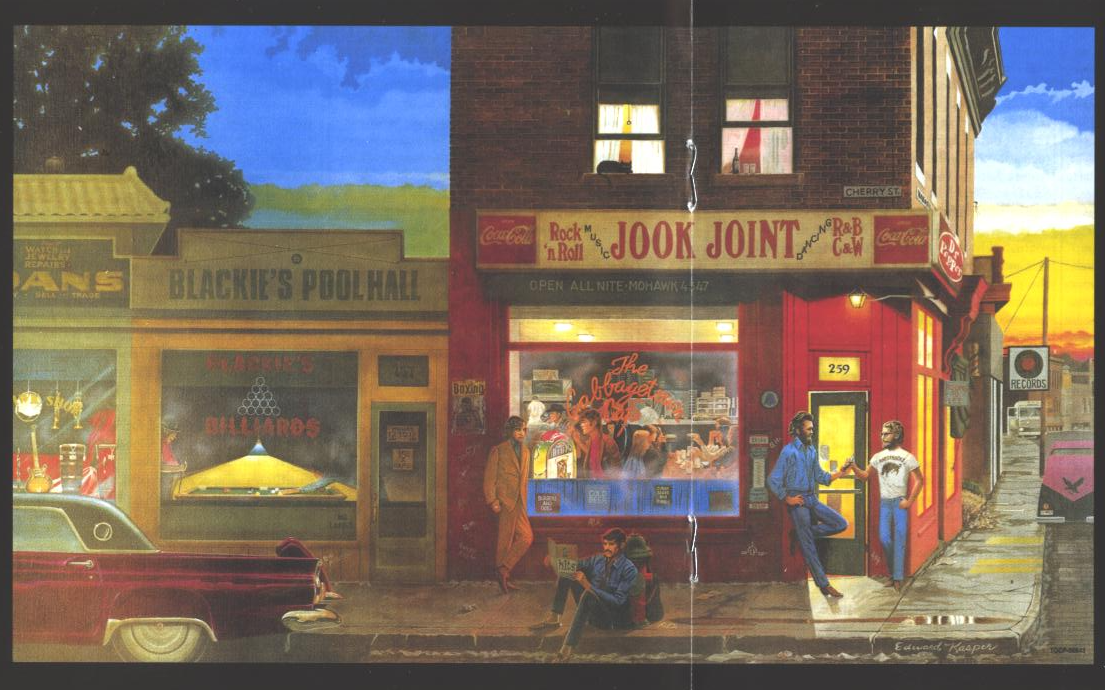GREAT PRETENDERS
The Band Transforms the Classics
The Band, Moondog Matinee, 1973
(from PublicArts, 2001)
BEFORE THE EXPLOSION of tribute albums in the 1990s, the subgenre of rock cover efforts was a scrappy tradition that usually signaled trouble. The Beatles were the prime example: after releasing The White Album in November of 1968, the fabs returned to the studio in January of 1969 with only tidbits of new material. To fill the time, they collapsed into a stream of oldies, or cover songs, as a source of inspiration. The sessions proved overlong and tiresome, and they shoved everything into the vaults for 18 months until the summer of 1970, when their new manager Allen Klein saw an opportunity to make some quick cash by releasing Let It Be, a cleaned-up version of those sessions (produced by Phil Spector). It included only one of dozens of covers (now circulating freely on the web), and it happened to be one of their own songs, “One After 909,” which they had left off their first album in 1963.
Where did these Canadians come upon this ineffably American sound? How could a band sound at once so historically authentic and yet so completely original?
In similar situations, other bands have followed suit. In 1973, the Band found itself flailing about: after touring with Bob Dylan in 1966 and recording the mysterious Basement Tapes while everyone else freaked out during the summer of 1967, the group released two boldly understated albums, Music From Big Pink (1968), and The Band (1969), which vaulted them into greatness. Pink had four definitive Dylan covers (“Tears of Rage,” “This Wheel’s On Fire,” “I Shall Be Released,” and “When I Paint My Masterpiece”), and one by the inimitable honky-tonker Lefty Frizzell (“Long Black Veil”), which pitched their sound somewhere between cutting edge folk-rock and vintage backwoods C&W. So sure was their attack that in a recent Rolling Stone article about Dylan collectors, “Dylanologist” Mark Jacobson referred to “Long Black Veil” as a Bob Dylan song.
It’s diffcult to overstate the effect these records and the Dylan connection had on the Band’s presence in the early ’70s. They were a kind of American Beatles, a band that reached aesthetic heights while commanding a broad, progressive audience. Such heights are difficult to attain, harder still to sustain. The Band’s follow-up albums—Stage Fright (1970) and Cahoots (1971)—were curiosities, mostly for the way their elusive sound sometimes eluded even them. While the songwriting could still be sturdy, their inspiration seemed largely spent. After Northern Lights––Southern Cross (1975), they threw themselves a retirement party on Thanksgiving of 1976 with The Last Waltz (1978) and packed off for a studio career that produced only one lackluster album (Islands in 1977) before they fell to pieces. Now, the Band’s catalog is getting the treatment it’s long deserved: digital remastering that preserves their fragile tone and extra tracks that give aesthetic clues to their work habits. The leftover take of “Up On Cripple Creek” reveals a lockstep arrangement that’s at once loose and refined. (Beware, however, of Rock Of Ages, which while sonically enhanced, contains a lackadaisical Dylan appearance on the second CD with a slow version of “Like a Rolling Stone” that sounds more miffed than energized.) Larger questions still hover over their work: where did these Canadians come upon this ineffably American sound? How could a band sound at once so historically authentic and yet so completely original? If such music had sources, what would they be?
Moondog Matinee makes sense of the Band in ways their original material never could. For starters, there are rich, emotionally persuasive white treatments of black sources: Richard Manuel’s humble recitation of Bobby “Blue” Bland’s “Share Your Love With Me,” and Rick Danko’s achingly modest read of Sam Cooke’s “A Change Is Gonna Come.” And if Moondog Matinee does nothing more than introduce new listeners to former light heavyweight (“Kid Chocolate”) Lee Dorsey, the New Orleans-by-way-of-Portland-Oregon singer, it will have worked a marvel. (“If a smile had a sound, it would be the sound of Lee Dorsey’s voice,” recalled Allen Toussaint.) Best known for his 1966 hit, “Working in the Coal Mine,” Dorsey’s influence extends to John Lennon, who sang Dorsey’s “Ya Ya” on his solo covers album Rock’n’Roll. The bonus tracks include a studio version of an original, “Endless Highway” (which only appeared on the essential 1974 live album with Dylan, Before the Flood), and Chuck Berry’s “Back to Memphis,” which the Band used to open its Watkins Glen set (the “live” version sounds punchier, but it’s just got added crowd noise). This ensemble worked the greatest creativity within the strictest of formats, and, like the Beatles, understood how paying tribute could bring out the most expressive originality.
